Japan
Wood Products Prices
Dollar Exchange Rates of 25th
May
2022
Japan Yen 127.27
Reports From Japan
Private sector anticipates
improvement in business
environment
In March 2022 private-sector machinery orders by
domestic companies, an indicator of private sector
prospects, rose just over 7% from a month earlier
according to Cabinet Office data. The orders, which
exclude those for ships and from utility companies,
totalled around yen 870 billion.
This increase in machinery orders has been interpreted as
signaling the private sector anticipates an improvement in
the business environment. However, surging commodity
prices due to Russia's invasion of Ukraine will pull down
private consumption and is likely to slow a recovery from
the impact of the coronavirus pandemic.
See:
https://www.nippon.com/en/news/kd899810464173785088/japan's-march-machinery-orders-rise-7-1-on-month.html

Imported inflation 每 not what is needed
The consumer price index for April rose by 2.1% year-onyear,
the biggest increase in over 13 years excluding the
effects of the consumption tax hike. The Bank of Japan
(BOJ) Governor has forecast core consumer inflation will
remain around the Bank's 2% target for 12 months unless
energy prices drop sharply.
However, he anticipates that prices would not rise
"sustainably and stably" unless accompanied by wage
increases. This has been interpreted as indicating the
recent increase in (largely imported) inflation alone would
not lead to a tapering down of monetary stimulus.

Center for Economic Research - growth will
gradually
lose momentum
The Japan Center for Economic Research has said
heightened uncertainties linked to "tensions in
international relations and military conflicts" will continue
to undermine growth prospects.
Japan's economy shrank 0.2% quarter-on-quarter in the
January-March period, slightly less than expected. This
followed the slight increase in the final quarter of 2021.
The impact of covid-19 and the rising cost of imports with
energy prices surging along with the weakening yen has
pushed up import costs.
GDP forecasts by economists surveyed by the Japan
Center for Economic Research averaged an annualised
5.18% expansion in the second quarter of 2022 but they
anticipate growth will gradually lose momentum in the
following quarters. For fiscal 2022 growth of just over 2%
is expected.
See:
https://japantoday.com/category/business/japan-1st-quartergdp-shrank-as-omicron-wave-hit
and
https://japantoday.com/category/business/focus-japaneconomy-may-rebound-but-faces-headwind-amid-pricesurge
Opening the borders
It has been announced that entry rules for non-Japanese
will be eased from 1 June raising the entry limit to 20,000
people per day and exempting some from testing on arrival
and quarantine rules.
To be exempt from arrival testing and quarantine
procedures, countries and regions will be divided
into three groups depending on the Covid-19 situation in
their respective countries.
See:
https://www.mofa.go.jp/ca/fna/page4e_001053.html#title28
House builders to get relief from surging timber prices
The domestic media has reported a decision by the
Forestry Agency to provide incentives to companies which
use of domestic sawnwood. This follows the government's
ban on sawnwood imports from Russia. It is reported that
around yen 4 billion will be made available from the
government*s reserve fund.
It is understood the Agency will provide subsidies to cover
half of costs of domestic sawnwood transportation if the
distance is 100 kilometres or more. The agency will also
cover half of sawnwood storage costs and support
sawnwood consumption by house builders.
See:
https://www.nippon.com/en/news/yjj2022051600695/?cx_recs_click=true
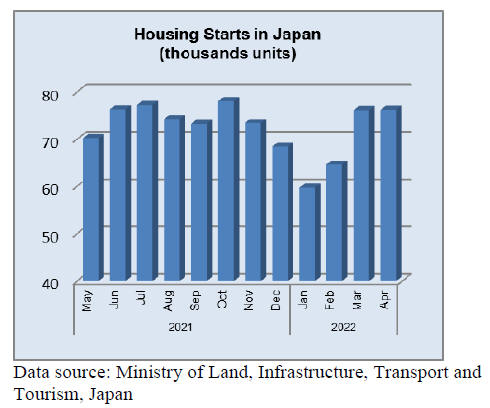
Increased perception of risk 每 yen
strenghens
Until the end of April the yen had been steadily weakening
against other major currencies driven mainly by the
widening interest rate gap between the Bank of Japan and
its counterparts. Investors are now concerned that the US
economy might tip into recession and this has, once again,
boosted the yen as a safe haven. The yen has strengthened
against the US dollar over the past two weeks.
Recent US housing date has been weak and the US
Federal Reserve has embarked on an aggressive rate-hike
cycle aimed at slowing the economy and containing
inflation. These moves have increased the perception of
risk.
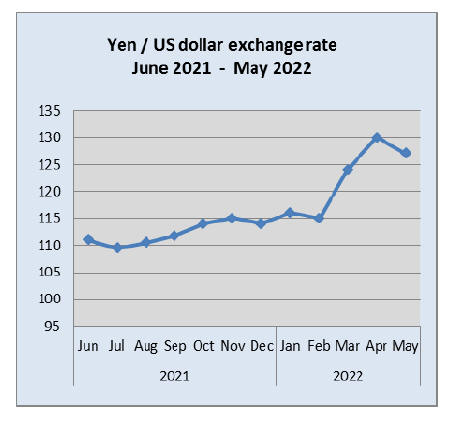
Assembled wooden flooring imports
The downward trend in the value of assembled wooden
flooring imports (HS441871-79) extended into March
marking the third consecutive decline. This is in contrast
to the steady rise in housing starts in the three months to
March.
Year on year, assembled wooden flooring imports were up
7% in March 2022 but the value of March imports was
down 3% from February 2022.The main category of
assembled flooring imported by Japan continues to be
HS441875 and this accounted for 61% of March 2022
imports with the main suppliers being China and Vietnam.
The value of imports of HS441873 and HS441879
together accounted for around 30% of the value of
assembled flooring imports in March.
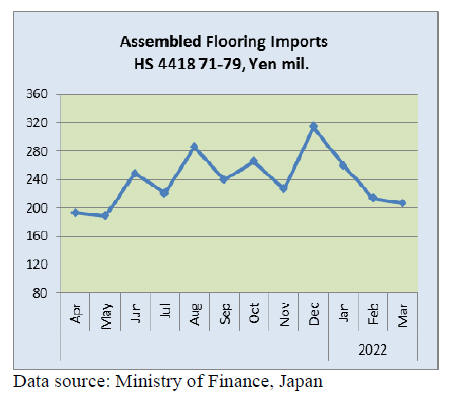
Plywood imports
The volume of plywood imports in March this year was up
18% from a month earlier, reversing the dip sen in
February. March 2022 import volumes were unchanged
from March 2021.
Malaysia and Indonesia were the main plywood shippers
to Japan and in March this year shipments from Indonesia
surged around 35% compared to the volumes imported in
February. Imports from Malaysia also rose from a month
earlier being up 16%.
The other two shippers of plywood to Japan, China
and
Vietnam each saw March shipments come in below those
in February. Shipments from China dipped 7% while
shipments from Vietnam were down 23% month on month
in March.
Of the various categories of plywood imported in March
2022 (as in other months) HS441231 was the most
common accounting for 90% of total plywood imports.
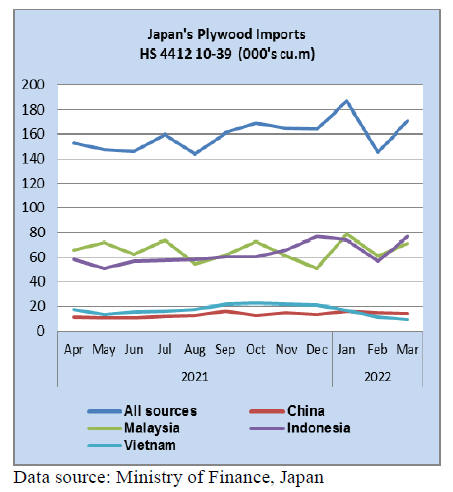
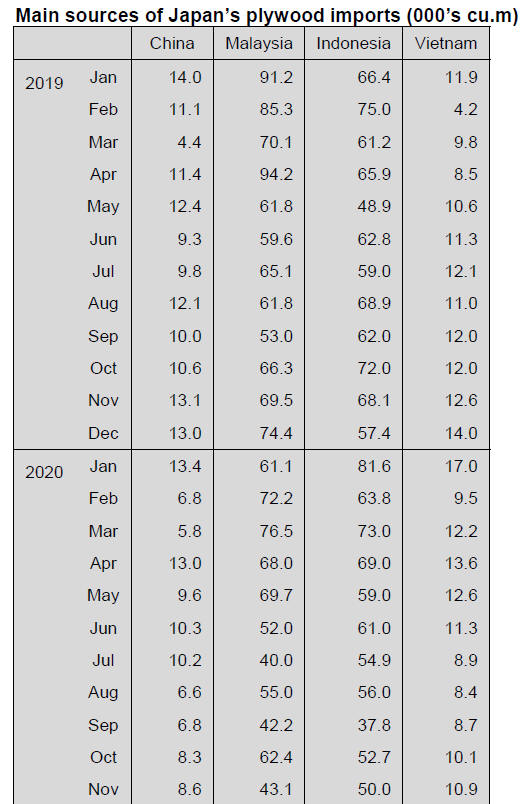 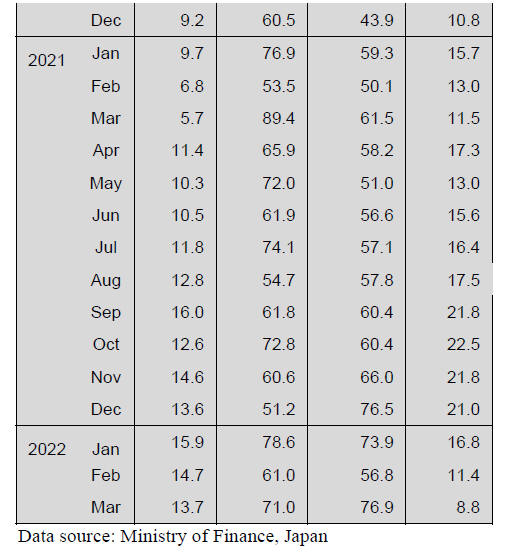
Trade news from the Japan Lumber Reports (JLR)
The Japan Lumber Reports (JLR), a subscription trade
journal published every two weeks in English, is
generously allowing the ITTO Tropical Timber Market
Report to reproduce news on the Japanese market
precisely as it appears in the JLR.
For the JLR report please see:
https://jfpj.jp/japan_lumber_reports/
Forestry Agency*s business plan
The Forestry Agency announced supply volume from the
national forest. According to the plan, log sales would be
3,073,000 cbms, 6% more than last year and timber sales
would be 3,877,000 cbms, 5% more. This is the first time
in 30 years that log sales are over three million cbms since
1992.
Log sales have been about 2,600,000 cbms a year
since1993 but I increased to 2,824,000 cbms last year.
In 3,073,000 cbms of log sales, 1,971,000 cbms, 64% will
be system sales, which log buyers make contract with the
Forestry Agency for certain volume so buyers have stable
supply of logs as opposed to auction sales. A balance of
1,102 M cbms will be sold at auction markets.
The Forestry Agency is well aware that demand of logs
increased by wood shock so it increases sales volume but
in timber sales, if the buyer does not harvest timber, log
supply does not increase. The Forestry Agency plans to
sell timber ahead of schedule if log demand climbs. Rough
estimate of timber sales last year increased to 1,655,000
cbms, the largest in last ten years.
Other than logs and timber sales, plans of newly planting
areas will be 5,600 hectares, 4% more than last year.
Under brush clearing areas will be 22,200 hectares, 1%
less.
Newly build logging road will be 113 kilometers, 8%
less.
Logging road building has been decreasing for last three
years but the Agency plans to reinforcement and
improvement of existing roads.
Marutama developed birch plywood
Marutama Plywood Co., Ltd., Hokkaido announced that it
has succeeded trial product of thin plywood with birch so
it becomes possible to manufacture and supply floor base
with birch veneer for face and back.
Supply of thin plywood relies on import products and
Marutama tries to develop manufacturing with local wood.
Marutama started &birch project* to utilize unused local
species in Hokkaido.
Key to this project is how to accumulate birch logs stably.
It has been working together with local government
offices and log supply companies and finally succeeded to
have 200 cbms of birch logs a month with average
diameter of 24 cm. Birch log inventory has been steadily
increasing.
It installed veneer jointer. Birch thin plywood is 3 mm
thick with three 1 mm veneer. It plans to produce 5,000
sheets a month, which is used for base board of printed
plywood. At the same time, it has been manufacturing
floor base plywood of fir core with birch face and back of
12 mm thick 3x6. Thickness of birch veneer is 1.75 mm
and that of fir is 3.03 mm and three layers make 11.8 mm
plywood. Monthly production will be 15,000 sheets.
Hokkaido has abundant resource of hardwood but
utilization of many species has not developed yet like
birch, which is considered junk wood. Marutama targets to
utilise such unused species to make with100% Hokkaido
products.
Excellent performance of trading firms
Major trading firms closed their books in March and wood
products contributed largely particularly companies, which
are engaged in North American business by booming
housing market in the U.S.A.
Itochu Corporation registered 31.5 billion yen
profit from North American businesses, 2.17
times more than last term.
Sojitz Corporation registered 2.9 billion yen
profit by Sojitz Building Materials Corporation,
5.8 times more than last term.
Itochu has subsidiary companies in North
America such as CIPA, veneer manufacturer,
PWT, LVL manufacturer registered 22.6 billion
yen by active housing market in the U.S.A.
Itochu Kenzai and Daiken Industry are also partly
owned by Itochu and both companies made
record profit.
Sojitz Building Materials Corporation made
record high profit of 2.9 billion yen.
South Sea lumber and logs
Export prices of Indonesian mercusii pine lumber are
about US$950 per cbm C&F, US$40 lower than April.
Order balance is decreasing and confusion of
transportation by container shipment is gradually solved.
Then pine harvest will start in May so that lumber mills
want to have some orders. Market prices in Japan are
unchanged at 125,000 yen per cbm FOB.
There used to be price difference of 10,000-20,000 yen
between Chinese lumber and Indonesian lumber but a
difference has been narrowing as worldwide inflation of
wood prices. Chinese red pine lumber prices are
unchanged at US$1,030-1,050 per cbm C&F.
The manufacturers are busy to cope with active domestic
demand and Russian lumber prices stay up high so they do
not have to reduce the prices to have orders. Market prices
in Japan are about 130,000 yen per cbm FOB truck. There
is possibility that the prices would advance because of
weakening yen.
Rainy season is over in South East Asia but log production
has not increased because of shortage of workers. Log
prices of meranti regular in Sarawak, Malaysia are US$410
per cbm FOB.
An increase of the volume of imported fuel
There has been a lot of announcements of planning to start
an operation of biomass power plants. The output will be
huge with low cost and be sold to overseas.
Some huge biomass power plants consider using domestic
pellets instead of Northern American pellets. Most of huge
biomass power plants sign up long-term contracts for
importing Northern American pellets. It is predicted that
there will be a peak of the volume of imported fuel in a
few years so the government policy for renewable energy
will be very important to this situation.
According to Agency for Natural Resources and Energy,
there had been 30% of all biomass power plants in Japan,
which were under the FIT (Feed-in Tariff), in operation at
the end of last September. The FIT has been ten years by
July in this year and operations at huge biomass power
plants have been standing out in recent years. It takes over
five years to start an operation due to the environmental
assessments, agreements with local area, designs,
construction, tests and so on.
The number of authorized small biomass power plants
with its output is less than 2000kw, has increased 45 cases
in a year. It does not take a lot of fuel fee at one case
because the fuel consumption is small. However, there is a
problem of using the heat against stable operation.
There is a huge biomass power plant in Iwaki city,
Fukushima prefecture by Able Energy, which was
established by Kansai Electric Power Company,
Incorporated.
The output is 112,000kw and it started operation
since
April in this year. Abou 440,000 ton of imported pellet
will be consumed in a year. There will be several huge
biomass power plants in Japan in the future.
The volume of imported pellet and PKS has increased
since last year and it became 5,600,000 ton in a year.
Especially, the volume of imported pellet in 2021 was
3,116,523 ton, 53.7% more than the year of 2020. The
volume of pellet from Vietnam was the highest volume
and the pellet from Canada was the second. The volume of
imported pellet will be about 10,000,000 ton by 2024 or
2025.
There will be a big difference between the imported pellet
and the domestic pellet. One of reasons is that people
prefer using pellet instead of PKS because the prices of
pellet are fixed for 15 years to 18 years by long term
contracts.
A long-term contract includes not only unchangeable
prices but also exchange rates and freights but there is a
force majeure included when a sudden rise of exchange
rates or freights occurred.
The spot prices of pellet soared to US$ 300, FOB per ton,
in Europe due to an invasion in Ukraine by Russia.
There is large demand in Europe so the Northern America
supplies pellets to Europe mainly and also buy the pellets
in Asia for other areas so that is why the prices of pellet in
Asia have been increasing. There is a possibility that the
volume of imported pellets will be 10,000,000 ton in a
year and this situation seems to continue for several years.
The prices of biomass fuel
The invasion of Ukraine by Russia influenced the prices of
lumber and plywood in Japan but the prices of wood for
wooden biomass power plants are not as much increased
as lumber and plywood.
Some areas in Western Japan have high-priced biomass
fuel though. Since there is much demand for domestic
lumber cause by the wood shock last year and even the
low-quality lumber is used as building materials.
Therefore, it is difficult to buy fuels for biomass power
companies and buy wood chips to plants.
The unused wood materials cost around 7,000 每 7,500 yen
per ton, arrived at a plant in Southern Kyusyu. Some
biomass power plants showed their condition that they buy
the unused materials for 8,000 yen to get those for sure
and there is a time limit.
In Kansai area and Shikoku area, it is also difficult to buy
the unused materials and the prices are 7,500 每 8,000 yen.
If the materials include barks, the prices are cheaper.
There was a biomass power plant which stopped operating
in last autumn because lumber companies bought
muchmaterials and there were no materials available for
biomass power plants.
In Chugoku area, the prices are slightly cheaper than other
areas. It is 6,000 yen. In Tohoku area, it is less than 6,000
yen and in Northern Kanto, it is 5,500 每 7,000 yen. There
is a big difference between Western Japan and Northern
Japan. The prices in Western Japan are high and low in
Northern Japan.
It is basic to use the unused materials which were around
the plant within 50 km, so it is hard to buy the materials
from distant area. of income and reduce fixed costs for
continuing operations. There is also a rule that the prices
are fixed due to the FIT. There are some biomass power
plants that to find a new source.
|